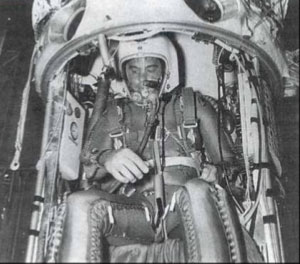50th anniversary of a forgotten space mission: Project Manhighby John C. Keel
|
| Most of all, Manhigh first tested the ability of human beings to function in the harsh extremes of high altitude, where the blue sky ends and space begins. |
In a sealed capsule filled with oxygen, nitrogen and helium, McClure soared to an altitude of 30,200 meters (99,700 feet) above the Tularosa Basin of New Mexico. He persevered through equipment failures that could have proven disastrous. His parachute came loose, but somehow he repacked it by hand while in the confined space capsule. Most significantly, the capsule’s cooling system failed, and temperature climbed, as it was beyond the radiation shielding of the atmosphere. Incredibly, McClure’s body temperature reached as high as 42.5ûC (108.5ûF), yet he remained conscious and recovered completely.
A graduate of Anderson High and Clemson, McClure also later became a member of the South Carolina Air National Guard. He flew the F-104 with the 157th Fighter Interceptor Squadron (now the 157th Fighter Squadron at McEntire JNGS, Eastover, SC). He was deployed to Spain during response to the 1962 crisis in Berlin. McClure passed away in January 2000. He was inducted into the International Space Hall of Fame in 2001.
Balloon missions continued briefly after Manhigh, including Excelsior and Stargazer, but all were soon overshadowed by NASA, and now they are all but forgotten. A few books have documented their feats, including The Pre-Astronauts: Manned Ballooning on the Edge of Space, by Craig Ryan, and Touching Space, by Gregory P. Kennedy. The Discovery Channel has aired a documentary on the pre-astronauts. A much-anticipated movie is also in progress to recount their amazing adventures.
Let us remember the remarkable, awe-inspiring achievements of McClure and the pre-astronauts. It was the pre-astronauts of Project Manhigh who were the first to see the curve of the Earth against the black void. As the space programs of the world prepare for the next stage, let us always remember those who have come before, for we pursue the most ancient dreams of mankind.
